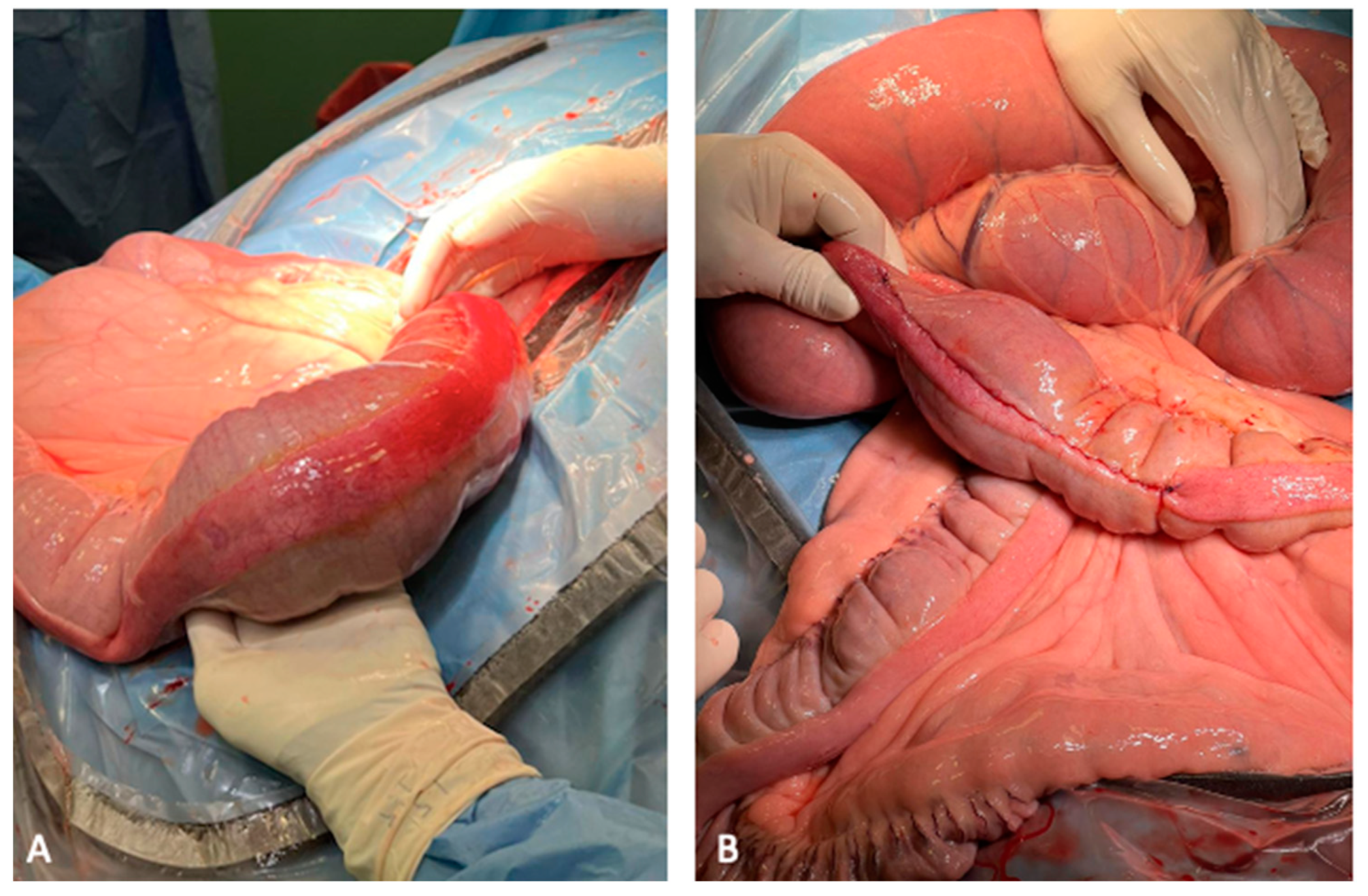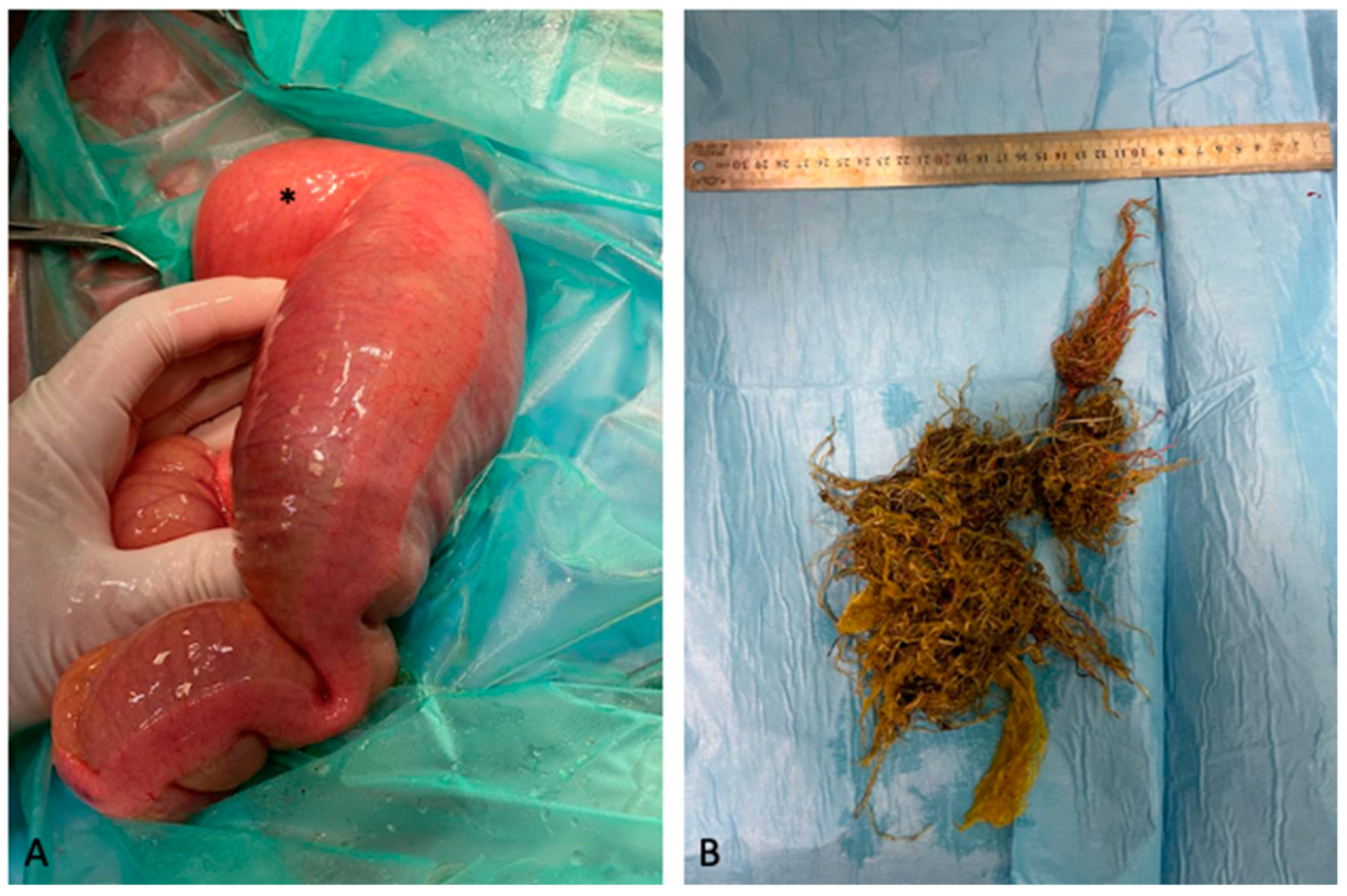Small Colon Faecalith with Large Colon Displacement in Ten Cases (2015–2023): A Detailed Case Description and Literature Review
Abstract
Simple Summary
Abstract
1. Introduction
2. Materials and Methods
Animals
3. Results
3.1. Case Descriptions
3.2. Outcome
4. Discussion
5. Conclusions
Author Contributions
Funding
Institutional Review Board Statement
Informed Consent Statement
Data Availability Statement
Conflicts of Interest
References
- Phillips, T.J.; Walmsley, J.P. Retrospective analysis of the results of 151 exploratory laparotomies in horses with gastrointestinal disease. Equine Vet. J. 1993, 25, 427–431. [Google Scholar] [CrossRef] [PubMed]
- Southwood, L.L.; Bergslien, K.; Jacobi, A. Large colon displacement and volvulus in horses: 495 cases (1987–1999). In Proceedings of the Seventh International Equine Colic Research Symposium, Manchester, UK, 14–16 July 2002. [Google Scholar]
- Abutarbush, S.M.; Carmalt, J.L.; Shoemaker, R.W. Causes of gastrointestinal colic in horses in western Canada: 604 cases (1992 to 2002). Can. Vet J. 2005, 46, 800–805. [Google Scholar] [PubMed]
- Mair, T.S.; Smith, L.J. Survival and complication rates in 300 horses undergoing surgical treatment of colic. Part 1: Short-term survival following a single laparotomy. Equine Vet. J. 2005, 37, 296–302. [Google Scholar] [CrossRef] [PubMed]
- Voigt, A.; Saulez, M.N.; Donnellan, C.M.; Gummow, B. Causes of gastrointestinal colic at an equine referral hospital in South Africa (1998–2007). J. South Afr. Vet. Assoc. 2009, 80, 192–198. [Google Scholar] [CrossRef] [PubMed][Green Version]
- Southwood, L.L. Large colon. In Equine Surgery, 5th ed.; Auer, A., Stick, J.A., Snyder, J., Eds.; Elsevier: St. Louis, MO, USA, 2019; pp. 601–609. [Google Scholar]
- Lopes, M.A.F.; White, N.A., 2nd; Crisman, M.V.; Ward, D.L. Effects of feeding large amounts of grain on colonic contents and feces in horses. Am. J. Vet. Res. 2004, 65, 687–694. [Google Scholar] [CrossRef]
- Mueller, P.O.E.; Moore, J.N. Rectal examination of horses with acute abdominal pain. Compend. Contin. Educ. Pract. Vet. 2000, 22, 606–615. [Google Scholar]
- Sellers, A.F.; Lowe, J.E. Review of large intestinal motility and mechanisms of impaction in the horse. Equine Vet. J. 1986, 18, 261–263. [Google Scholar] [CrossRef]
- Weese, J.S.; Holcombe, S.J.; Embertson, R.M.; Kurtz, K.A.; Roessner, H.A.; Jalali, M.; Wismer, S.E. Changes in the faecal microbiota of mares precede the development of post partum colic. Equine Vet. J. 2015, 47, 641–649. [Google Scholar] [CrossRef]
- Hanson, R.R.; Schumacher, J. Diagnosis, management and prognosis of small colon impactions. Equine Vet. Educ. 2021, 33, 47–56. [Google Scholar] [CrossRef]
- Prange, T.; Blikslager, A.T.; Rakestraw, P.C. Transverse and descending (small) colon. In Equine Surgery, 5th ed.; Auer, A., Stick, J.A., Snyder, J., Eds.; Elsevier: St. Louis, MO, USA, 2019; pp. 277–283. [Google Scholar]
- Plummer, A.E. Impactions of the small and large intestines. Vet. Clin. N. Am. Equine Pract. 2009, 25, 317–327. [Google Scholar] [CrossRef]
- Edwards, G.B. Diseases and surgery of the small colon. Vet. Clin. N. Am. Equine Pract. 1997, 13, 359–375. [Google Scholar] [CrossRef]
- Pierce, R.L. Enteroliths and other foreign bodies. Vet. Clin. N. Am. Equine Pract. 2009, 25, 329–340. [Google Scholar] [CrossRef] [PubMed]
- Herbert, E.W.; Lopes, M.A.F.; Kelmer, G. Standing flank laparotomy for the treatment of small colon impactions in 15 ponies and one horse. Equine Vet. Educ. 2021, 33, e51–e56. [Google Scholar] [CrossRef]
- Dart, A.J.; Snyder, J.R.; Pascoe, J.R.; Farver, T.B.; Galuppo, L.D. Abnormal conditions of the equine descending (small) colon: 102 cases (1979–1989). J. Am. Vet. Med. Assoc. 1992, 200, 971–978. [Google Scholar] [CrossRef] [PubMed]
- Tennant, B.; Wheat, J.; Meagher, D. Observations on the causes and incidence of acute intestinal obstruction in the horse. Proc. Am. Ass. Equine Practnrs. 1972, 19, 251–257. [Google Scholar]
- Edwards, G.B. A review of 38 cases of small colon obstruction in the horse. Equine Vet. J. 1992, 24, 42–50. [Google Scholar] [CrossRef]
- Rhoads, W.S.; Barton, M.H.; Parks, A.H. Comparison of medical and surgical treatment for impaction of the small colon in horses: 84 cases (1986–1996). J. Am. Vet. Med. Assoc. 1999, 214, 1042–1047. [Google Scholar] [CrossRef]
- Ruggles, A.J.; Ross, M.W. Medical and surgical management of small-colon impaction in horses: 28 cases (1984–1989). J. Am. Vet. Med. Assoc. 1991, 199, 1762–1766. [Google Scholar] [CrossRef]
- McClure, J.T.; Kobluk, C.; Voller, K.; Geor, R.J.; Ames, T.R.; Sivula, N. Fecalith impaction in four miniature foals. J. Am. Vet. Med. Assoc. 1992, 200, 205–207. [Google Scholar] [CrossRef]
- Frederico, L.M.; Jones, S.L.; Blikslager, A.T. Predisposing factors for small colon impaction in horses and outcome of medical and surgical treatment: 44 cases (1999–2004). J. Am. Vet. Med. Assoc. 2006, 229, 1612–1616. [Google Scholar] [CrossRef]
- Blikslager, A.T. The paradox of diarrhoeal disease and small colon obstruction. Equine Vet. Educ. 2016, 28, 424–425. [Google Scholar] [CrossRef]
- Blikslager, A.T. Gastric impaction and large colon volvulus: Can one lead to the other? Equine Vet. Educ. 2015, 27, 460–461. [Google Scholar] [CrossRef]
- Hackett, E.S.; Embertson, R.M.; Hopper, S.A.; Woodie, J.B.; Ruggles, A.J. Duration of disease influences survival to discharge of Thoroughbred mares with surgically treated large colon volvulus. Equine Vet. J. 2015, 47, 650–654. [Google Scholar] [CrossRef] [PubMed]
- Nikahval, B.; Vesal, N.; Ghane, M. Surgical correction of small colon faecalith in a Dare-Shuri foal. Turk. J. Vet. Anim. Sci. 2009, 33, 357–361. [Google Scholar]
- Schumacher, J.; Mair, T.S. Small colon obstructions in the mature horse. Equine Vet. Educ. 2002, 14, 19–28. [Google Scholar] [CrossRef]
- Hallowell, G.D. Retrospective study assessing efficacy of treatment of large colonic impactions. Equine Vet. J. 2008, 40, 411–413. [Google Scholar] [CrossRef] [PubMed]
- Lopes, M.A.F.; White, N.A., 2nd; Donaldson, L.; Crisman, M.V.; Ward, D.L. Effects of enteral and intravenous fluid therapy, magnesium sulfate, and sodium sulfate on colonic contents and feces in horses. Am. J. Vet. Res. 2004, 65, 695–704. [Google Scholar] [CrossRef]
- Giusto, G.; Cerullo, A.; Gandini, M. Gastric and large colon impactions combined with aggressive enteral fluid therapy may predispose to large colon volvulus: 4 cases. J. Equine Vet. Sci. 2021, 102, 103617. [Google Scholar] [CrossRef]
- Wiley, J.; Tatum, D.; Keinath, R.; Chung, O.Y. Participation of gastric mechanoreceptors and intestinal chemoreceptors in the gastrocolonic response. J. Gastroenterol. 1988, 94, 1144–1149. [Google Scholar] [CrossRef]
- Suthers, J.M.; Pinchbeck, G.L.; Proudman, C.J.; Archer, D.C. Risk factors for large colon volvulus in the UK. Equine Vet. J. 2013, 45, 558–563. [Google Scholar] [CrossRef]
- Salem, S.E.; Maddox, T.W.; Antczak, P.; Ketley, J.M.; Williams, N.J.; Archer, D.C. Acute changes in the colonic microbiota are associated with large intestinal forms of surgical colic. BMC Vet. Res. 2019, 15, 468. [Google Scholar] [CrossRef] [PubMed]


| Patient ID | Age | Breed | Sex | Weight (Kg) | HR (bpm) | RR (bpm) | CRT (sec) | PCV (%) | TP (g/dL) | Blood Lactate (mmol/L) | Intestinal Motility | Net Reflux (L) |
|---|---|---|---|---|---|---|---|---|---|---|---|---|
| 1 | 18 y | Quarter Horse | Female | 490 | 60 | 30 | 3 | 38 | 7.2 | - | Absent | 5 |
| 2 | 8 y | Friesian | Female | 630 | 56 | 20 | 2 | 39 | 5.2 | - | Absent | 0 |
| 3 | 21 y | Unknown (pony) | Gelding | 260 | 40 | 20 | 2 | 27 | 6.0 | 3.3 | Absent | 0 |
| 4 | 7 y | Unknown (pony) | Female | 120 | 60 | 24 | 2 | 30 | 6.0 | 3.3 | Absent | 9 |
| 5 | 17 y | Murgese | Gelding | 630 | 60 | 24 | 2 | 35 | 7.5 | 3.3 | Decreased | - |
| 6 | 8 m | Quarter Horse | Male | 205 | 84 | 24 | 2 | 34 | 6.4 | 3.8 | Unremarkable | 0 |
| 7 | 26 y | Unknown (pony) | Gelding | 340 | 60 | 28 | <2 | 30 | 6.8 | 0.9 | Decreased | - |
| 8 * | 29 y | Unknown (pony) | Gelding | 340 | 52 | 24 | 2.5 | 31 | 6.3 | 2.3 | Decreased | 0 |
| 9 | 16 y | Shetland | Female | 80.5 | 36 | 20 | 2 | 24 | 6.7 | 3.1 | Decreased | - |
| 10 | 20 d | Shire | Male | 180 | 28 | 40 | 2 | 30 | 6.8 | 1 | Decreased | - |
| Patient ID | Postoperative Complications | Short-Term Outcome | Long-Term Outcome; Duration |
|---|---|---|---|
| 1 | Laminitis–Hyperlipemia | Discharged | Lost at follow-up |
| 2 | Diarrhoea–Pyrexia | Discharged | No complications; 12 months |
| 3 | Laminitis–Hyperlipemia | Discharged | No complications; 12 months |
| 5 | None | Discharged | Incisional infection; 6 months |
| 6 | Thrombophlebitis–Pyrexia | Discharged | Incisional infection; 8 months |
| 7 | None | Discharged | Recurrence of problem; 13 months |
| 8 * | None | Discharged | Died 2 months after discharge |
| 9 | Hyperlipemia | Discharged | No complications; 40 days |
| 10 | Surgical site infection–Pyrexia | Discharged | Lost at follow-up |
Disclaimer/Publisher’s Note: The statements, opinions and data contained in all publications are solely those of the individual author(s) and contributor(s) and not of MDPI and/or the editor(s). MDPI and/or the editor(s) disclaim responsibility for any injury to people or property resulting from any ideas, methods, instructions or products referred to in the content. |
© 2024 by the authors. Licensee MDPI, Basel, Switzerland. This article is an open access article distributed under the terms and conditions of the Creative Commons Attribution (CC BY) license (https://creativecommons.org/licenses/by/4.0/).
Share and Cite
Scilimati, N.; Cerullo, A.; Nannarone, S.; Gialletti, R.; Giusto, G.; Bertoletti, A. Small Colon Faecalith with Large Colon Displacement in Ten Cases (2015–2023): A Detailed Case Description and Literature Review. Animals 2024, 14, 262. https://doi.org/10.3390/ani14020262
Scilimati N, Cerullo A, Nannarone S, Gialletti R, Giusto G, Bertoletti A. Small Colon Faecalith with Large Colon Displacement in Ten Cases (2015–2023): A Detailed Case Description and Literature Review. Animals. 2024; 14(2):262. https://doi.org/10.3390/ani14020262
Chicago/Turabian StyleScilimati, Nicola, Anna Cerullo, Sara Nannarone, Rodolfo Gialletti, Gessica Giusto, and Alice Bertoletti. 2024. "Small Colon Faecalith with Large Colon Displacement in Ten Cases (2015–2023): A Detailed Case Description and Literature Review" Animals 14, no. 2: 262. https://doi.org/10.3390/ani14020262
APA StyleScilimati, N., Cerullo, A., Nannarone, S., Gialletti, R., Giusto, G., & Bertoletti, A. (2024). Small Colon Faecalith with Large Colon Displacement in Ten Cases (2015–2023): A Detailed Case Description and Literature Review. Animals, 14(2), 262. https://doi.org/10.3390/ani14020262








